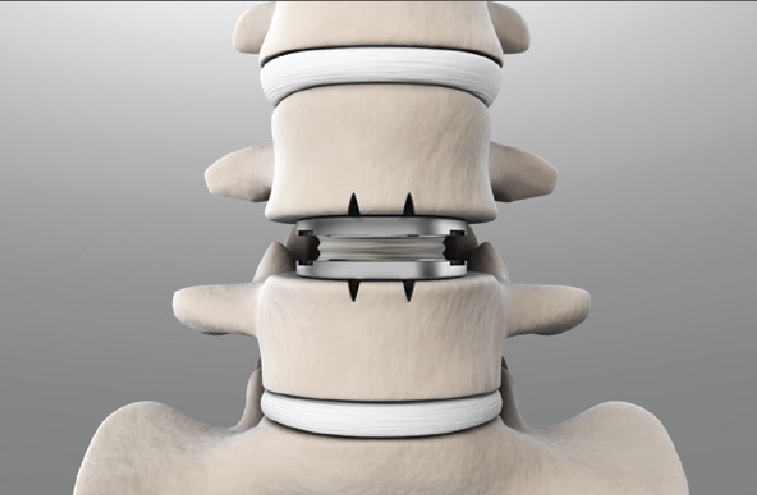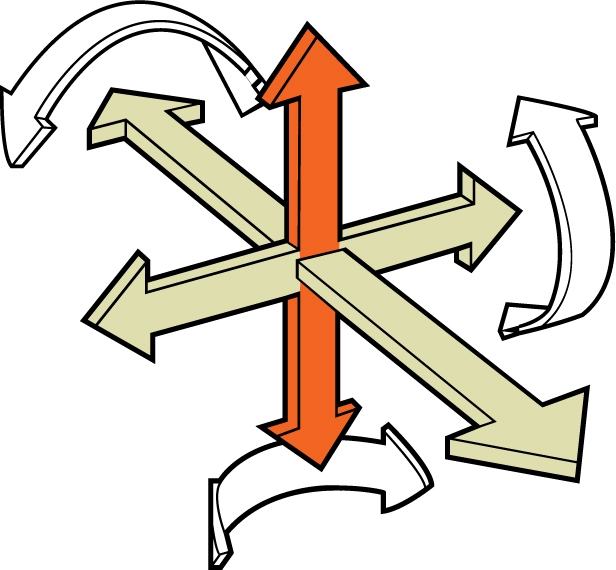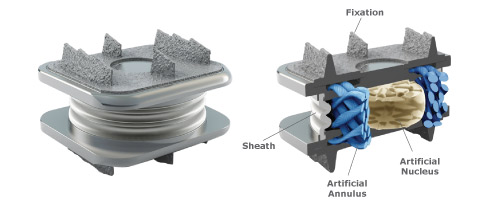Spinal Disc Replacement: supporting pain free mobility through next generation Spinal Prosthesis
Key Facts: Spinal Disc Replacement (Artificial Spinal Disc)
- Indications: Spinal Disc Degeneration with chronic back pain
- Strategy: Spinal Disc Replacement (ADR) replaces the intervertebral Disc with a disc prosthesis maintaining natural mobility of the vertebrae of the spine
- Inpatient treatment: 2 days for cervical disc replacement and 10 days for lumbar disc replacementana
- Outpatient Rehabilitation: 14 days for cervical artificial disc and 21 days for lumbar artificial disc replacement
- Earliest flight home: 7 days after surgery for cervical disc replacement and 21 days for lumbar disc replacement
- Recommended flight home: 14 days after surgery for cervical disc replacement and 21 days for lumbar disc replacement
- Time before showering: 7 days after cervical disc replacement surgery, 10 days after lumbar disc replacement surgery
- Recommended time off work: 4 weeks for both lumbar and cervical disc replacement
- Suture removal: Cervical disc replacement - no sutures. Lumbar disc replacement - after 14 days
- Time before driving a car: Cervical disc replacement - 1 week. Lumbar disc replacement - 28 days
When is spinal disc replacement necessary?
 Artificial spinal disc or disc replacement: When is it necessary? © Spinal Kinetics
Artificial spinal disc or disc replacement: When is it necessary? © Spinal Kinetics
Total disc replacement is performed when a patient is experiencing pain from a pinched nerve in the lumbar spine due to a diseased or damaged disc.
Lumbar (lower back) spinal disc degeneration is one of the most commonly diagnosed spinal diseases among adults.
At the Gelenk-Klinik spinal centre we have worked hard to find safe and reliable ways to help patients with chronic back pain caused by lumbar spinal disc degeneration.
Why is spinal disc replacement preferable to spinal fusion?
Advantages of disc prosthesis over spinal fusion
- Restores mobility of the spine
- Faster healing and recovery following surgery
- Better long-term biomechanical results for the patient (flexibility and mobility)
- Quicker rates of return to work and recreational sports
- No wear and tear in the adjacent areas of the spine
- Next-generation artificial disc replacements restore the natural motion of the human spine
For many decades spinal fusion was the only option for patients with this condition, however, spinal fusion creates increased wear and tear in the adjacent areas of the spine. Spinal fusion is effective and safe, but always compromises the dynamics and biomechanics of the human spine. This means that the long-term flexibility and mobility of the patient may be compromised.
Following more than ten years of development, artificial discs have been improved to such an extent, that they are now considered an effective and safe treatment option for spinal disc degeneration.
The modern M6 artificial spinal discs offer a particularly effective alternative to the earlier established practice of spinal fusion surgery.
Artificial spinal discs have the potential to preserve mobility in the spinal column, almost matching the mobility of a normal healthy spine.
What to expect from an artificial spinal disc?
These artificial discs help improve mobility in a spine segment that has been affected by disk degeneration.
Next generation Spinal Disc Replacement using the dynamic M6 spinal disc prosthesis
The natural properties of a spinal disc
- The natural intervertebral disc shell (annulus fibrosus) is made up of annular layers of connective tissue.
- The elastic sheath allows movement in every direction.
- The soft "elastic" core of the intervertebral disc (nucleus) has a shock absorbing effect.
- The shell of the intervertebral disc prosthesis is also "elastic". It allows movement and at the same time provides stability.
Dimensions of mobility are preserved with artificial disc replacement
 The artificial spinal disc must be able to support the six dimensions of natural mobility of the spine. © Spinal Kinetics
The artificial spinal disc must be able to support the six dimensions of natural mobility of the spine. © Spinal Kinetics
The natural spinal disc supports vertebral mobility in every dimension. The spinal disc prothesis must imitate this property, otherwise the natural dynamic of the spine will be lost. It is only with the latest generation of artificial disc replacement (M6), that the natural dynamic of the spine can be preserved.
Lumbar disc replacement using an M6-L prosthesis allows flexibility in each dimension. It supports the natural biomechanics of spine function providing a durable and permanent solution.
What is an artificial spinal disc?
 The prosthetic disc consists of a soft, shock absorbing core surrounded by an elastic mesh, which is able to support mobility and stability in every direction. This internal structure is then enclosed in a mantle, which protects the prosthesis from the surrounding tissue. © Spinal Kinetics
The prosthetic disc consists of a soft, shock absorbing core surrounded by an elastic mesh, which is able to support mobility and stability in every direction. This internal structure is then enclosed in a mantle, which protects the prosthesis from the surrounding tissue. © Spinal Kinetics
Modern disc prostheses have a movable core, which allows movement in all directions, analogous to the core of the natural, biological disc. Only with this level of mobility, can a lasting, painfree result be achieved. This core is able to support strain, pressure, rotation, and shear (when the vertebrae are shifted sideways). Any limitation on this mobility, decreases the durability of the prosthesis, because of the threat of wear and loosening. Former artificial disc prosthesis were designed with a nonelastic polyethylene core. These suffered from early loosening, as they were not effective as shock absorbers. Because they did not imitate the natural action of the disc, the patient suffered the consequences of compromised spinal biomechanics.
Benefits of the artificial spinal disc
The use of the M6-L artificial disc is now supported by evidence of safe function and mobility stretching back decades.
Experience with this type of artificial disc prosthesis in long term use is extremely positive.
Hundreds of patients have already been treated with the new generation artificial spinal disc replacements in spine and back centres in Germany. It is a stable and safe procedure, which gives patients with lumbar disc degeneration a pain free and more mobile long term result, than the more established practice of spinal fusion surgery.
To find out if you, or a member of your family could benefit from spinal disc replacement, please contact us via the enquiry form link below.
Who qualifies for artificial spinal disc replacement?
Checklist for Artificial Disc Replacement
- Diagnostic MRI shows disc degeneration
- Cause of pain is neurosurgical
- Non-surgical therapy has been without success
- Other causes of chronic pain have been systematically excluded
- Chronic pain for more than six months
Normally patients qualifying for artificial disc replacement will have been suffering from pain for more than six months. From a diagnostic MRI scan they will show clear signs of spinal disc degeneration. The neurosurgeon will, however, be very careful to confirm that the true cause of the pain is disc degeneration.
Many cases of spinal disc degeneration are pain-free. Only persistent pain caused by spinal disc degeneration backs up the decision for surgical intervention. This means that if a patient requests an artificial disc replacement, the back specialist will need to establish a thorough and complete medical history.
For artificial disc replacement to be successful, the true cause of the pain must be accurately established.
Artificial disc replacement will only be considered if the pain cannot be relieved by non-surgical treatment such as physiotherapy or physical therapy.

Contraindications for artificial disc replacement
In these cases, artificial disc replacement surgery must not be performed.- Severe Osteoporosis
- Vertebral Body Fracture
- Facet Joint Osteoarthritis
- Segmental Instability
- Inflammation and Infections
- Injuries of Spinal ligaments
- Severe Spinal stenosis
- Tumors of the spine
The first step is to remove the diseased disc from between the vertebral bodies.
Next the end surfaces of these vertebral bodies are cleaned to make them ready for fitting the prosthesis. The vertebral bodies are also eased apart slightly to relieve the pressure on the pinched nerve and make space for the prosthesis.
After that the M6-L lumbar disc replacement prosthesis is inserted into the disc space and tapped into position on the surface of the vertebral bodies.
As the spine is returned to normal posture, this seats the endplates into the vertebral bones and holds the prosthesis in place.
After surgery the position of the prosthesis is carefully checked by the surgeon, visually and with x-rays.
Rehabilitation following Artificial Spinal Disc Replacement
Generally after spinal disc replacement, activity has no serious limitations. Usually, on the day of surgery, unaided walking is possible and encouraged. The hospital stay following a disc prosthesis operation is 2-5 days.
After the proper healing of the surgical wound, the patient will be discharged. A special corset must be worn for six weeks. After that time, the patient is normally able to return to a full professional and recreational life.
Muscle training following Artificial Spinal Disc Replacement
Following surgery, the disc prostheses in both the lumbar and cervical spine and the surrounding muscles, are affected by immobility and resting during the healing process. The patient is therefore advised to follow a targeted rehabilitation program to build up the supporting muscles.
In the case of lumbar spine replacement, in-house rehabilitation treatment in a dedicated rehabilitation clinic for up to three weeks following surgery is recommended.




